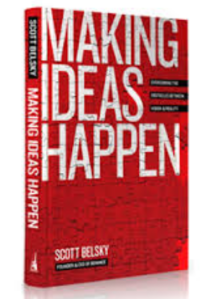The recurring theme in this book is that great things are 1% inspiration and 99% perspiration and far too many “ideas” people remain in the world of ideas without developing the skills and habits to actually turn those ideas into action.
This man loves his ideas in threes and I was taken by a few of them so I’m taking the opportunity to document the main framework of the book before returning it to the library:
organization and execution
We generate three useful sets of notes. (I love the simplicity of this, I may never need to file again)
- Action steps – this is what we are actually going to do next
- Reference material – much of which we never return to but we need to know its there
- Backburner items – ideas that may become action steps but not just yet
…and this simple frame gives us what we need for setting up systems in paper and online to manage these three types of treasures. Obviously organisational systems are quite a personal art and things are becoming more searchable online. I am finding a simple chronological system quite effective for my notes and have adopted a friend’s idea of putting a checkbox next to any item I need to action, so I can find my action steps within my notes. Belsky also warns against the lull in motivation that happens mid project when one is prone to a shiny new idea – put it in your backburner and finish the job at hand is the message!
The forces of community
Three types are identified here – the doers, the dreamers and the incrementalists – and classic examples of partnerships that worked. The idea is that a doer needs a dreamer and vice versa. Incrementalists can do both and when partnered with a doer, tend to unleash their inner creative. Partnering with a dreamer turns them into a project manager. The point is that many high profile dreamers had doers in their lives that were fundamental to their success.
This section emphasises the importance of sharing your ideas and intentions widely as a useful forum for honing ideas and way of grounding your commitment in intentions that others are relying on. (A similar theme emerges in ‘How to Build Influence’ as ideas need to be respirated through a community to become robust.)
Leadership capability
The ideal team works well together, has complementary skills and everyone’s voice is heard – often with robust disagreement before the team move forward together. Not easy to come by but worth nurturing. The idea here that intrigued me in this section was creating the ability to kill ideas – coming back to the theme that we have far too many ideas and not enough hard work to turn only the best into something real. Self leadership is the final theme ending on the note of loving our work: Love drives us and it disappoints us and we need to reconcile that love to find a manageable balance between loving our work and continuing to produce and learn when our work falls short of ideal.
A worthwhile read!



Pingback: Bedeviled by procrastination | changing weather by Heather Smith
Pingback: Change starts from within | changing weather by Heather Smith